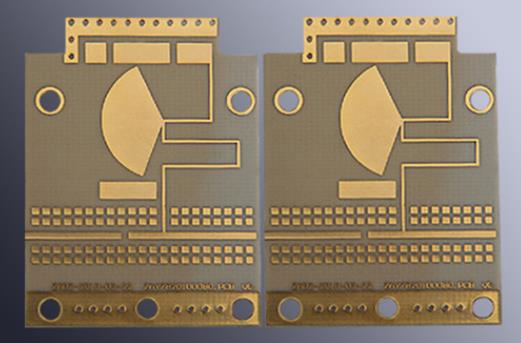High-frequency boards are special circuit boards with a higher electromagnetic frequency, used in high-frequency (frequency greater than 300MHZ or wavelength less than 1 metre) and microwave (frequency greater than 3GHZ or wavelength less than 0.1 metre) PCBs The circuit boards in this category are the circuit boards that are produced in the microwave substrate cladding boards operated in the departmental crafts of the popular rigid circuit board manufacturing methods or by using the special processing methods. Generally speaking, high-frequency board can be defined as the frequency of 1GHz above the circuit board.
Classification of PCB High Frequency Boards.
Ceramic filled thermoset material
Processing method:
The processing flow is similar to that of epoxy resin/glass woven fabric (FR4), except that the sheet is more brittle and prone to breakage. When drilling holes and gongs, the life span of drill nozzles and gong knives is reduced by 20%.
PTFE (Polytetrafluoroethylene) material processing method:
1. Cutting material: protective film cutting material must be kept to avoid scratches and indentations
2. Drilling:
2.1 Use brand new drill bit (No. 130), one by one is best, pressure foot pressure 40psi
2.2 Aluminium plate as a cover plate, then use 1mm melamine gasket to clamp the PTFE plate tightly.
2.3 After drilling, use an air gun to blow out the dust in the holes.
2.4 Use the most constant drilling machine and drilling parameters (basically, smaller holes, faster drilling speeds, smaller chip loads, lower return speeds)
3. Over-hole treatment
Plasma treatment or sodium naphthalene activation treatment is favourable for hole metallisation.
4. PTH immersion copper
4.1 After micro-etching (micro-etching rate is controlled at 20 micro inches), start the PTH pull on the plate from the degreasing bath in the degreasing tank.
4.2 If necessary, pass a second PTH, starting only from the estimated cylinders, into the circuit board.
5. Soldermask
5.1 Pre-treatment: Acid wash the board, do not machine grind the board.
5.2 Pre-treatment and post-baking of the board (90℃, 30min), brush green oil curing
5.3 Triple bake: 80℃, 100℃, 150℃ for 30min each (if the substrate surface is coated with oil) , it can be reworked: wash off the green oil and reactivate it)
6. Causeway
Lay the white paper on the line surface of the PTFE board, stuck with FR-4 substrate or phenolic baseboard, etching thickness of 1.0MM de-copper:

High Frequency Board Material
When selecting substrates for high-frequency circuit PCBs, it is necessary to look specifically at the material DK and its transformation properties at different frequencies.
For high-speed signal transmission requirements or characteristic impedance control requirements, the focus is on DF and its performance under frequency, temperature and humidity.
Under the premise of frequency variation, common substrate materials show a pattern of large changes in DK and DF values.
Especially in the frequency range of 1 MHz to 1 GHz, their DK and DF values vary greatly.
According to the in-line coating, the DK value of common epoxy resin-glass fibre cloth based substrate material (common FR-4) is 4 at 1 MHz frequency.

High Frequency Circuit Board
7. The DK value changes to 4.19 at 1 GHz frequency. beyond 1 GHz, the change in its DK value tends to be steeper.
The trend of its change is with the increase in frequency and become smaller (but the magnitude of the change is not large), for example, in the l0GHz below, ordinary FR-4 DK value of 4.15, high - speed and high-frequency characteristics of the frequency change. Under the environment, the change of DK value is relatively small. Under the transition frequency from 1MHz to 1GHz, DK is mostly connected to the transition of 0.02 scale.
Its DK value has a small tendency to decrease under the premise of frequency change from low to high.
The dielectric loss factor (DF) of common substrate materials is affected by frequency changes (except for high-frequency scale changes), and the change in DF value is larger than that of DK for Dk - Df contrast.
Its change in discipline tends to increase, so when evaluating the high-frequency characteristics of a substrate material, the focus of the examination is on the environment in which the DF value changes.
For substrate materials with high-speed and high-frequency characteristics, there are two different types of transformation characteristics of ordinary substrate materials at high frequencies: one type changes with frequency and its (DF) value changes very little.
The other type is close to the normal substrate material in the magnitude of change, but has a lower (DF) value of its own.